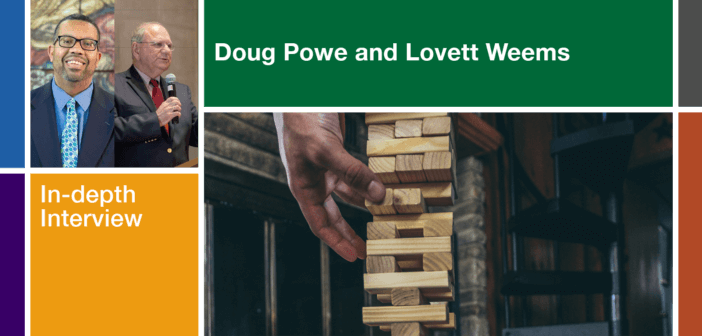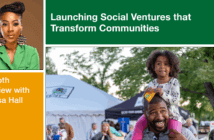How can you bring about meaningful change in your church? F. Douglas Powe Jr. and Lovett H. Weems Jr. maintain that genuine change also involves continuity. Ann Michel of the Lewis Center staff interviews them about their new book Sustaining While Disrupting and how leaders can sustain key traditions and systems while simultaneously pursuing new initiatives and innovations.
Listen to this interview, watch the interview video on YouTube, or continue reading.
Ann Michel: The central premise of your book is that genuine change involves continuity — that to bring about meaningful change a church leader can’t focus solely on new initiatives but must also sustain key traditions and systems. Can you explain this premise, Lovett?
Lovett Weems: Church leaders have to do two things at once — sustain and disrupt. They have to sustain the ongoing ministries of the church while at the same time innovating into areas required for the future. It’s hard for leaders to get this combination right. How much do you focus on sustaining, keeping things going, and even improving things? And how much do you focus on the new, what’s needed for the future, and things you have not done before?
Church leaders often don’t see great vitality in the past or present and may identify personally more with the future or with innovation. It’s easy to regard these two as almost competing themes. On the one hand, leaders face so many demands just keeping people happy with what’s going on. But at the same time, they know they need to focus on the future. These have to be seen together — past and future, continuity and change.
For one thing, virtually all your assets are in the past that is connected to what’s going on now — your people, money, property, credibility. So, you can’t just ignore what is in order to work on what may be. You’re not trying to innovate in spite of all the demands of the present, but instead you’re trying to innovate in light of those assets that you already have.
So, for example, let’s say your congregation has lost its connection to its community. The members no longer live there. People in the church don’t know people in the community. People in the community don’t know people in the church. There’s very little connection day in and day out. You’re hoping that can change. So, one approach would be to minimize your efforts toward keeping everything going and focus on new efforts to engage the community. But, as you start looking a little closer at the church’s past, you discover it hasn’t always been this way. The church and the community really grew up together. The public school and your church were the first buildings built in the community. Many community organizations owe their origin to the church. Many used to meet in the church. It was a place for public forums and public gatherings, so now, as you look to the future, you’re not saying, “We’ve got to quit being this ingrown church and become a new community-based church.” Instead, you’re saying “We’re falling in love with our community again and becoming what we were from the beginning.”
Leading change is more evolution than revolution. You want to build from that past. Instead of saying, “Our future is becoming a church that’s not like anything we’ve been before,” you say, “We’re going to be more of what we’ve always been.” Continuity and change must go together. But they take different skills and different efforts.
Ann Michel: Are there examples of this approach to change in Scripture, Doug?
Doug Powe: We certainly think so. One example is in the book of Acts. The book begins with a sustaining community that seeks to continue to embody what Jesus delivered to the disciples. They were going to continue to work in the community, to take care of those in their midst who were struggling, and to live out the Scripture, which was for them, of course, the Old Testament. But questions arise around how Gentiles can be brought into the Christian faith and the very practical issues of circumcision and dietary laws, but the underlying issue is how do we pursue God’s calling, whether we’re Jewish or Gentile.
You start off with the disciples gathering and Peter speaking up and talking about what is revealed to him. And then, as you continue reading, Peter and Cornelius both have a dream or vision. And this is where the innovation comes in. Peter envisions Jews and Gentiles together. Reading this today, we understand that it’s important, but we may not realize what a big deal this would have been to both Peter and Cornelius at that time. It was really earth-shattering to think about these two groups coming together and Cornelius’s vision of inviting Peter to come to his house.
It’s interesting that Peter had the vision, but the innovation really doesn’t get legs until Paul picks it up and runs with it. Paul was an outsider, a person who at one point was persecuting Christians but now sees things differently and sees Gentiles as partners in moving God’s vision forward. So, it’s the outsider that helps the innovation take place. It can be hard for insiders to embody something completely new. In Acts, we have Peter, who is brilliant at sustaining what the disciples have learned and doing this very well, but it takes Paul, an outsider, to really think about how this can move in a different direction. And he does so with a huge risk. He says, “The Gentiles don’t have to be circumcised. They can embody God’s calling and be faithful without being circumcised.”
In Acts, you see this tension Lovett described of how you sustain and embody community, which is critically important, but at the same time allow critical innovations to take place. But it often involves someone with a different perspective coming from the outside. And it also often involves taking risk, which can be particularly challenging for congregations that like to play it safe.
Ann Michel: Focusing on the sustaining side of the equation, what are some things that leaders need to prioritize?
Doug Powe: Whether it’s someone who has been a part of the church for 50 years or someone who just joined last week, it’s critically important that we help them live into the vision of the church and grow in their relationship with God. We have to have vital worship. We have to have vital ministries to connect them with their neighbors and experience what it means to participate in God’s vision. If you ignore these basics just to try new things, you’re not sustaining those key foundational pieces that have helped the church get where it is today.
Another important piece is pastoral care. You can’t overlook this aspect of sustaining the congregation. It’s really important to take care of the flock and journey with folk as they’re dealing with life’s challenges. If a leader simply ignores these things, they might be brilliant at creating new things, but it will still be a challenge because the church isn’t truly living out the vision of what they’re called to do.
Ann Michel: You suggest a number of key practices essential to both sustaining and innovating. One is the “So That” formula. Why are these two little words so important to effective leadership and change?
Lovett Weems: In our book Bearing Fruit, Tom Berlin and I developed the concept of “So That” and describe the phrase as “the two most important words for fruitful leadership.” The church tends to focus a great deal on intentions and activities. But the Bible talks more about fruitfulness. What is the harvest God is calling us to reap? And “So That” helps keep us focused on the desired fruits of our work.
Think for a moment about Vacation Bible School. Churches of many different sizes, traditions, and locations have Vacation Bible School every year. Yet even in the most active and vital congregations, it’s rare that someone can complete this simple sentence: “Each year we have Vacation Bible School so that ….” Defining your “So That” is a way to name what you hope God will do in the lives of the children, their parents, and in the community as a result of your Vacation Bible School. Unless you’re clear on that end goal, you don’t know what teachers to recruit, what literature to use, whether your VBS should be in the daytime or at night, whether you can charge a fee or whether it should be free. But so often in evaluating our efforts we fail to ask, “Did our Vacation Bible School achieve what God is calling us to do in the lives of children?” Instead, the question is just, “Did we have a Vacation Bible School?”
We treat other things the same way. Take worship. We think of worship in terms of the activities, and we do those well. But have we ever said our church has worship so that …? What do we expect will be different because of our worship? One year from now, if we do worship well, how will the lives of our members be different? How will our community be different one year from now? Once you’ve identified that, you can say, “We have a choir so that ….” It’s not about music apart from the “So That” or purpose of our worship.
Ann Michel: At another point in the book, you suggest four criteria for discerning what a congregation’s next faithful step might be. Doug, can you share these?
Doug Powe: So far, we’ve talked a lot about helping people think about sustaining leadership. But the book is equally about innovating and taking the next faithful step. We’re really trying to help leaders think about the balance between those two. How do you take the next faithful step in terms of sustaining? And in terms of innovation, what are some things to think about in determining the next faithful step?
The first thing is potential. How do we determine the potential for something we want to either sustain or for an area in which we may want to innovate? And that means we have to evaluate some of the priorities of the congregation. We have to evaluate our mission and what we’re trying to do. Sometimes, congregations will say their priority is to reach young families. So, as you’re thinking about potential, you need to figure out what’s really happening with regard to young families. What are the rhythms of the congregation? What are the things that are occurring in the congregation?” Again, sometimes an outsider can help us see this, so invite someone who’s not connected to the congregation to come to worship, to come to a business meeting, to come to some Sunday school classes or ministries, just to observe and see what’s going on. Let’s say this person shows up at worship and notices that, when a child makes a noise or moves, people stare or start whispering quietly and it makes the young family feel uncomfortable. So, while the congregation may say, “We want to reach young families,” the potential to do so is diminished by the very rhythms of how they actually live out their life together. Trying to really figure out our rhythms helps us figure out the potential for what we’re trying to do.
Second, we think about reach. Reach helps us think not only about who we say we want to reach but what will actually help us make that happen. Again, if we’re trying to reach young families, we really need to study our community. Are there schools close by? Are there other places where children are playing outside? Where do we actually see children in our community? Just making the statement “we want to reach children” without studying the community sets us up for failure. What do we need to do to reach those with whom we seek to connect? As Lovett says, that actually starts with the question, “What do we need to learn?”
Third and critically important is readiness. Many times, we may have the potential to do something, but are we really ready to make the change? There may be an elementary school a block away from the church, but if people in the congregation say, “We really would prefer the children go to children’s church. We don’t want them in the worship service,” they may not be ready to welcome new families. Some internal work may be required to discuss what it really means to make families a priority and to connect with them. And if we say children should be in children’s church, we may not be the family-oriented community we think we are. Too often, congregations skip over the question of readiness in thinking about taking the next faithful step.
The final criterion is fit. Is the new idea really a good fit for the congregation? Switching the analogy to the new world of hybrid worship, are we simply letting people look at the worship service that we are doing without changing anything? Or are we willing to actually change something so that online worshipers can feel they’re part of the experience? Are we willing to let them fit into what we’re trying to do?
Potential, reach, readiness, and fit help us to take the next faithful step, whether we’re trying to sustain or whether we’re trying innovate.
Ann Michel: Do you have suggestions for how to discipline and order a congregation’s decision making to bring all these considerations to the table?
Doug Powe: Leaders really need to start with self-evaluation. Some of us are naturally better at sustaining. Others are naturally better at creating and trying to push the edge of the envelope. Both of these are needed. But if you know your own strengths and preferences you can build capacity in the other area. Sometimes we think that one person can do everything. As we all know, that’s not possible. The key is really understanding your strengths and then having others around you who might help you build capacity in places where you’re not as strong.
It’s also important to think about starting smaller. Oftentimes we want to move from “A” to at least “M” and skip over all the letters of the alphabet in between. But sometimes you need to go from “A” to “B.” You just need to take “that next faithful step.” If you make it to “B” you actually have done something wonderful. Sometimes leaders encourage a congregation to dream so big that they think they need to become totally different overnight. But the reality is, in taking your journey, you have to be authentic to who you are, and the next faithful step is just getting from “A” to “B.”
Ann Michel: If a church leader wanted to embrace your advice about leadership that balances sustaining and disrupting, how might they get started? What’s a good first step?
Doug Powe: It’s really important for a leader to think first about what they need to learn to help the congregation move forward. Oftentimes, we’ll go to a workshop or hear people talk and we get great ideas. And we get really gung-ho about a new idea without stopping to think about what we need to learn to implement that idea. If the goal is to start a second service, what do you need to learn? If the goal is to reach young families in the community, what do we need to learn? Whatever the new idea, you need to start with the question, “What we need to learn?” When you take the first step of learning, you may feel that you’re not really doing anything, but learning is critical if you’re really going to succeed and move forward.
Ann Michel: Lovett, what do you think is the best first step for someone just starting down this road of leadership?
Lovett Weems: I like to say, “Leaders don’t have to have the answers, but they must have the right questions.” And a good question a leader might ask of himself or herself and of many others who are knowledgeable about the situation is, thinking about your church and its vitality, where is the church most vulnerable five years from now? And what is something that, if done well, could make your church far more vital five years from now? In other words, what’s the big issue?
The notion of taking the next faithful step works because it’s toward something else. Refurbishing the fellowship hall to make it accessible to the community is not an end in itself. But it’s a step toward that goal of reengaging the community. The same is true of beginning a community choir for children. None of the smaller things by themselves will reach that preferred future. It requires many of those things working together. And that’s how we eventually are able to get to a point where we can look back and say, “We never could have dreamed that we would be here.” Too many of us focus too much on the present without getting the big picture and helping others to get that big picture, so we’re not clear on that vision to which God is most calling us now.
Related Resources
- Sustaining While Disrupting: The Challenge of Congregational Innovation (Fortress Press: 2022) by F. Douglas Powe Jr. and Lovett H. Weems Jr. Available at Fortress Press, Cokesbury, and Amazon.
- The Messy Art of Leading Change: An In-Depth Interview with Mike Bonem
- Conquering the Challenges of Change by Ann A. Michel
- Does Your Faith Community Live out of Memory or Imagination? by Bill Wilson




